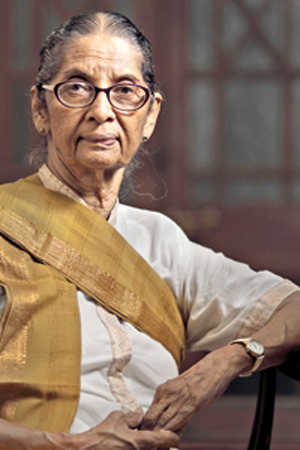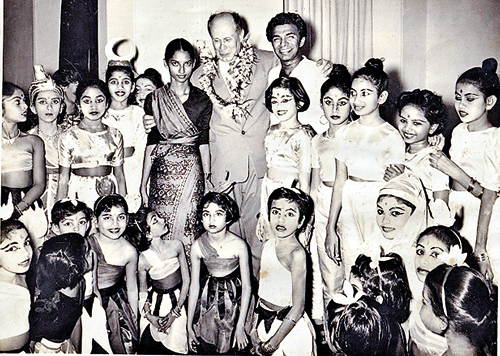Vajira’s pioneering steps in children’s ballet

Vajira - A recent portrait by Luxshmanan Nadaraja
Histories of the tri-traditional dances of Sri Lanka, Kandyan, Low Country and Sabaragamuwa, generally highlight a handful of pioneering women, point out their significance as the first female dancers on stage and summarize their life stories. In these narratives, the contribution of these artists is presented as creating a space for female dancers on stage. Yet, these female pioneers emerged on stage at a critical point in the journey of the tri-traditional dances from ritual space to stage, overlapping with the early efforts of their male counterparts, both the ritual masters (the ‘gurunnanses’) and stage dancers to break in proscenium audiences. Most often these narratives do not explore the contribution of these female pioneers to transform the dance on the proscenium, as performers, teachers, choreographers, troupe leaders, producers and costume designers.
In this context, Vajira’s life story provides a useful prism to understand the development and contribution of the female dancer beyond that of a performer and teacher to a co-conceiver who pushed the boundaries of the tri-traditional dance performance. Although the female dancer had historical antecedents (recorded in historical texts, literature and rock and wood carvings) and was found in specific contexts in the pre-independence era, Kandyan dance, at least in its ritual form, had no formal place for her. Vajira was preceded by individual dancers, such as Miriam de Saram and Chandralekha, who broke new ground in the late 1930s and early 1940s. Although Vajira began performing in the mid-1940s, her official debut was at the Pageant of Lanka, held to celebrate the island’s independence in February 1948.
Embodying Lasya
Vajira is probably the first professional female Kandyan dancer. She took up full-time dance as a vocation, performing on stages in Sri Lanka and cultural capitals across the world. Vajira was viewed as the epitome of the female performance and was referred to as the ‘prima ballerina of Kandyan dance’. In the media she was described as embodying the lasya (loosely translated as feminine) form of the dance, whereas Kandyan is seen to be a more thandava (masculine) form, particularly in a South Asian perspective. Although Sri Lankan reviewers often highlighted her grace, they did not always capture the underlying strength and weight that she brought to the dance and her efforts to challenge her male counterparts on stage, to match their steps and leaps.
In a similar vein, the epithet highlights the recognition she garnered over five decades of performance, but refers to only one or two of many contributions she made to the dance. As a female dancer regularly performing on stages across the country and later internationally, she served as a role model for young women passionate about taking up dance as a vocation. She also served as teacher to successive generations of dancers and at 89 years of age would probably be conducting classes if not for the COVID-19 pandemic.
Beyond teaching sections of the traditional repertoire as taught to her by her teacher and later husband, Chitrasena, and his guru Lapaya Gurunnanse, she developed her own pedagogy. Drawing from her exposure to other dance traditions during tours abroad and when artists such as Martha Graham visited the island (1956), Vajira developed a series of exercises to break down Kandyan dance movements that could be used to train dancers. These exercises made the processes of teaching and learning much easier and ensured greater clarity and consistency in lines and stances. In doing so she also expanded the range of movement, for instance adding floor to kneeling and standing exercises, whereas the ritual form has no movement where the dancer lies at floor level.
While establishing herself as a principal dancer in the Chitrasena Dance Company, by the late 1950s she had begun exploring choreography. This included re-setting or creating new traditional items, collaborating with the master drummer and composer Piyasara Silpathipathi and experimenting with the emerging form of dance theatre, the mudra natya.
Children’s Mudra Natya
An area rarely highlighted in articles on Vajira’s contribution to dance, is her role in creating and conceiving children’s mudra natya or ballets. The term ‘children’s ballet’ may conjure up an image of a year-end pantomime for students to demonstrate their skills to relatives and friends, where the focus is less on artistry and more on performance and participation. Although Vajira’s productions employed simple storylines, they were often grand productions with large casts, original music scores and fantastical sets. While Vajira’s productions provided space for children of different ages to perform, they did not compromise on originality or artistry.

Chitrasena and Vajira with a diplomat after the performance of Vanaja (Children’s Ballet) in 1958
It is remarkable that barely a decade after Chitrasena’s attempts at devising mudra natya, Vajira took on the challenge of exploring the medium for child performers in the early 1950s. The mudra natya or Sinhala ballet emerged around the 1930s and 1940s and marked a significant departure from the dance dramas; the former used dance as the primary narrative tool, while the latter used a range of media such as song, spoken word and dance. She replicated Chitrasena’s approach of using Kandyan dancing as the framework for the choreography without being bound by it, integrating natural movement and mime.
Vajira claims that she began producing children’s ballets because she was inspired by the talent of her students at the Kalayathanaya and felt she owed it to them to create pieces to showcase their talent. This seems to have been her ethos for choreography in general. Vajira also states that she was inspired by the musicians who lived in the Colpetty school where she lived and taught with Chitrasena. The children’s mudra natyas typically involved group scenes with different sets of children dancing in formation and solos for the more advanced and skilled (generally older, teenage) dancers, with a strong emphasis on expression and natural movement. Working with children from a broad age range (6 to 20 years), she invested significant time to develop their differing capacities. These productions gave the next generation of female soloists, such as the young Khema and Upeka, an opportunity to perform and gain stage exposure.
Kumudini was Vajira’s first production, presented in the early 1950s. It is an allegorical story on impermanence, told from the perspective of a flower that blooms and is eventually trampled. For Vajira, the ballet marked an important turning point: “When I started to experiment with creative dance, Chitra[sena] did not try to stop me. With 15-minute ballets I got more experience to do larger stories.”
Virtuoso collaborators
The list of collaborators involved in the children’s ballets over the years include some of leading figures in the Sinhala cultural world, attesting to the originality and quality of these productions. The scores for the ballets, for instance were composed by some of the most prominent musicians of the time, including Ananda Samarakone, Amaradeva, Titus Nonis, Somadasa Elvitigala and Victor Perera. These productions provided a space for musical experimentation, such as a chorus of four live performers, in addition to an orchestra in Rankikilli (1965), for which Lionel Algama set the music, while Piyasiri Wijeratne wrote the lyrics. The evocative sets and costumes, such as those used to create an underwater marine world for Hapana (1979), were designed by the famous artist and designer Somabandu. His son, Ravibandu, took on this role for one production, Anaberaya (1976).
In devising the plots, Vajira drew inspiration from multiple sources, often finding material in children’s literature and folk stories from Sri Lanka and elsewhere. Vajira collaborated with the acclaimed local children’s author Sybil Wettasinghe to devise the plot for Nil Yakka. Hapana was inspired by the children’s book Swimmy by Leo Lionni, first published in Italian in 1963.
Although the children’s ballets were Vajira’s domain, Chitrasena played a critical role in helping to provide the theatrical elements. As she noted “when I produced shows he would put finishing touches at the end.” These included vital elements such as sets, lighting, fund raising and advertising. Over time Anjalika, Vajira’s daughter took over the children’s ballets, including with the Punchi Paada age group (4.5 to 7 years).
The children’s ballets offered Vajira the space to develop her creative skills and expand her repertoire. By the 1960s she was able to use her choreographic skills to devise sequences in Chitrasena’s mudra natya; an initial effort was the swan sequences in Nala Damayanthi in 1963, where she also played one of the central roles. In 1968 Vajira created a short mudra natya, Gini Hora, for her older teenage students.
It was in the mid-1980s with the production Shiva Ranga (1985) that Vajira took on more of a central role of director, not only choreographing but also devising the plots and taking charge of other key elements of staging a mudra natya. Through the multi-dimensional role of performer, teacher, choreographer and director, she established her status as one of the most influential figures in traditional dance on stage.



